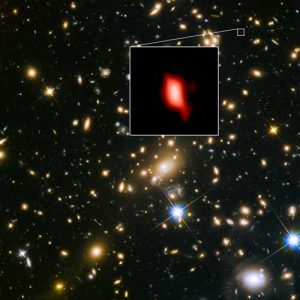
Astronomers have used observations from the Atacama Large Millimeter/submillimeter Array (ALMA) and ESO’s Very Large Telescope (VLT) to determine that star formation in the very distant galaxy MACS1149-JD1 started at an unexpectedly early stage, only 250 million years after the Big Bang. This discovery also represents the most distant oxygen ever detected in the Universe and the most distant galaxy ever observed by ALMA or the VLT. The results will appear in the journal Nature on 17 May 2018.
An international team of astronomers used ALMA to observe a distant galaxy called MACS1149-JD1. They detected a very faint glow emitted by ionised oxygen in the galaxy. As this infrared light travelled across space, the expansion of the Universe stretched it to wavelengths more than ten times longer by the time it reached Earth and was detected by ALMA. The team inferred that the signal was emitted 13.3 billion years ago (or 500 million years after the Big Bang), making it the most distant oxygen ever detected by any telescope. The presence of oxygen is a clear sign that there must have been even earlier generations of stars in this galaxy.
“I was thrilled to see the signal of the distant oxygen in the ALMA data,” says Takuya Hashimoto, the lead author of the new paper and a researcher at both Osaka Sangyo University and the National Astronomical Observatory of Japan. “This detection pushes back the frontiers of the observable Universe.”
In addition to the glow from oxygen picked up by ALMA, a weaker signal of hydrogen emission was also detected by ESO’s Very Large Telescope (VLT). The distance to the galaxy determined from this observation is consistent with the distance from the oxygen observation. This makes MACS1149-JD1 the most distant galaxy with a precise distance measurement and the most distant galaxy ever observed with ALMA or the VLT.
“This galaxy is seen at a time when the Universe was only 500 million years old and yet it already has a population of mature stars,” explains Nicolas Laporte, a researcher at University College London (UCL) in the UK and second author of the new paper. “We are therefore able to use this galaxy to probe into an earlier, completely uncharted period of cosmic history.”
For a period after the Big Bang there was no oxygen in the Universe; it was created by the fusion processes of the first stars and then released when these stars died. The detection of oxygen in MACS1149-JD1 indicates that these earlier generations of stars had been already formed and expelled oxygen by just 500 million years after the beginning of the Universe.
But when did this earlier star formation occur? To find out, the team reconstructed the earlier history of MACS1149-JD1 using infrared data taken with the NASA/ESA Hubble Space Telescope and the NASA Spitzer Space Telescope. They found that the observed brightness of the galaxy is well-explained by a model where the onset of star formation corresponds to only 250 million years after the Universe began.
The maturity of the stars seen in MACS1149-JD1 raises the question of when the very first galaxies emerged from total darkness, an epoch astronomers romantically term “cosmic dawn”. By establishing the age of MACS1149-JD1, the team has effectively demonstrated that galaxies existed earlier than those we can currently directly detect.
Richard Ellis, senior astronomer at UCL and co-author of the paper, concludes: “Determining when cosmic dawn occurred is akin to the Holy Grail of cosmology and galaxy formation. With these new observations of MACS1149-JD1 we are getting closer to directly witnessing the birth of starlight! Since we are all made of processed stellar material, this is really finding our own origins.”
Source: ESO
